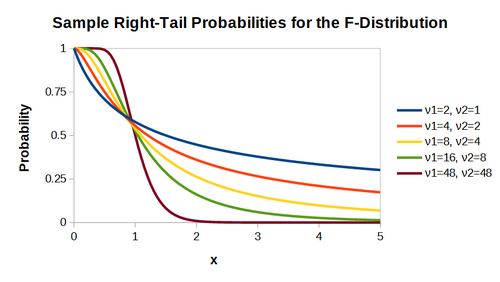Documentation/Calc Functions/F.DIST.RT
TDF LibreOffice Document Liberation Project Community Blogs Weblate Nextcloud Redmine Ask LibreOffice Donate
Function name:
F.DIST.RT
Category:
Statistical Analysis
Summary:
Calculates a right-tail probability value for the F-distribution with the given degrees of freedom. The calculated value represents the area under the probability density function curve to the right of the specified value.
F-distributions (named in recognition of Sir Ronald Fisher) are a family of continuous probability distributions on the interval [0, +∞) that often arise in the statistical analysis of variance. The F-distribution has two characteristic parameters, known as the degrees of freedom for the numerator and the degrees of freedom for the denominator and these determine the shape of the distribution.
Syntax:
F.DIST.RT(Number; Degrees freedom 1; Degrees freedom 2)
Returns:
Returns a real number in the range [0, 1], which is the right-tail probability from the F-distribution for the given arguments.
Arguments:
Number is a non-negative real number, or a reference to a cell containing that number, which is the value to be used to determine the right-tail probability.
Degrees freedom 1 is a positive integer, or a reference to a cell containing that number, which is the degrees of freedom for the numerator of the F-distribution.
Degrees freedom 2 is a positive integer, or a reference to a cell containing that number, which is the degrees of freedom for the denominator of the F-distribution.
- If any of Number, Degrees freedom 1, or Degrees freedom 2 is non-numeric, then F.DIST.RT reports a #VALUE! error.
- If Number is less than 0.0, then F.DIST.RT reports an invalid argument error (Err:502).
- If either Degrees freedom 1 or Degrees freedom 2 is less than 1, then F.DIST.RT reports an invalid argument error (Err:502).
- If either Degrees freedom 1 or Degrees freedom 2 is a non-integer value, then F.DIST.RT truncates it to an integer value.
Additional details:
- Calc's FDIST and F.DIST.RT functions perform identical calculations. The requirements for FDIST are specified in ODF 1.2; F.DIST.RT is provided for interoperability with Microsoft Excel.
- The formula for F.DIST.RT is:
- [math]\displaystyle{ \text{F.DIST.RT}(x;\:ν1;\:ν2)~=~ \frac{\Gamma \left( \frac{ν1+ν2}{2} \right) \left( \frac{ν1}{ν2} \right)^\frac{ν1}{2}} {\Gamma \left( \frac{ν1}{2} \right) \Gamma \left( \frac{ν2}{2} \right)} \times \int_{x}^{∞} \frac{t^{\frac{ν1}{2}-1}} {\left( 1+\frac{ν1}{ν2}t \right)^{\frac{ν1+ν2}{2}}}\:dt }[/math]
- Note also that the formula
=F.DIST.RT(x; y; z)is equivalent to=1-F.DIST(x; y; z; TRUE) - The following figure shows right-tail probability plots for five sample F-distributions.
- The name space for F.DIST.RT is
COM.MICROSOFT.F.DIST.RT. - For more information about F-distributions, visit Wikipedia's F-distribution page.
Examples:
| Formula | Description | Returns |
|---|---|---|
| =F.DIST.RT(A1; A2; A3) where cells A1:A3 contain the values 0.8, 8, and 12 respectively. | Here the function calculates a right-tail probability for a specified F-distribution. Note that the formula =F.DIST.RT(0.8; 8.75; 12.9) returns the same value because the non-integer Degrees freedom 1 and Degrees freedom 2 values are truncated. |
0.614339643745812 |
| =F.DIST.RT(5; 6; 6) | Here the function calculates a right-tail probability for a specified F-distribution. Note that the formula =FDIST(5; 6; 6) returns the same value. |
0.0354938271604938 |
Related LibreOffice functions:
ODF standard:
Related (or similar) Excel functions:
F.DIST.RT
